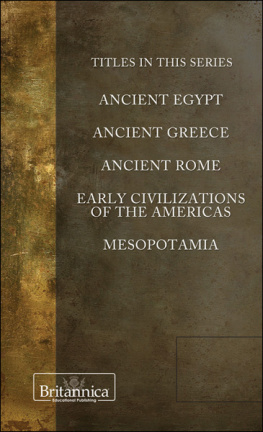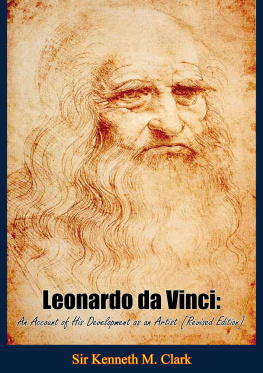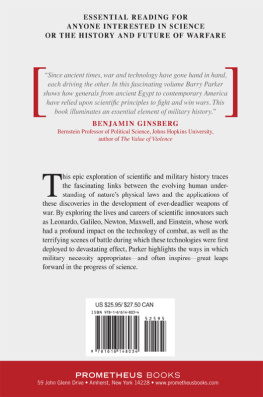WORKS
OF
MAN
RONALD CLARK

This electronic edition published in 2011 by Bloomsbury Reader
Bloomsbury Reader is a division of Bloomsbury Publishing Plc, 50 Bedford Square, London
WC1B 3DP
Copyright Ronald W. Clark, 1985
The moral right of author has been asserted
All rights reserved
You may not copy, distribute, transmit, reproduce or otherwise make available this publication
(or any part of it) in any form, or by any means (including without limitation electronic, digital,
optical, mechanical, photocopying, printing, recording or otherwise), without the prior written
permission of the publisher. Any person who does any unauthorised act in relation to this
publication may be liable to criminal prosecution and civil claims for damages
ISBN: 9781448206575
eISBN: 9781448206216
Visit www.bloomsburyreader.com to find out more about our authors and their books
You will find extracts, author interviews, author events and you can sign up for
newsletters to be the first to hear about our latest releases and special offers
Many factors have contributed through the centuries to the stumble forward of progress which has enabled men to exploit the laws of nature by using ever more complex buildings and machines. Not the least has been chance, that arbiter which, as Winston Churchill once said, can govern which side of a tree an officer steps and thus settle whether he ends up a mangled wreck or survives as a successful commander.
Yet, if there is one component on which most if not all technological progress rests, it is probably that described by the late A.P.Rowe, director of Britains Telecommunications Research Establishment whose ability to keep its wartime staff of radio geniuses and prima donnas working as a team played a significant part in winning the war. The birth of radar, he once wrote, awaited contact between those with a need and those with a contact which would meet that need in this case contact between H.E.Wimperis, director of scientific research at the Air Ministry, and Robert Watson-Watt of the Radio Research Station, working at the time on a radio technique without thought of military application. At least as far back as 1921, Marconi had noted that the position of ships could be pinpointed by their reflection of radio waves. Edward Appleton, probing the layers of the ionosphere a few years later, had reported similar phenomena. Both naval and Army research workers had speculated on the possibilities of radio-location in the later 1920s. Yet it was only after the 1934 Air Exercises had shown that London was wide open to attack from the air, that radar was pulled into existence as a possible way of meeting the danger.
An urgent need of this kind has invariably been required before a potential technological advance has been changed from dream to reality. Thus the steam-driven caterpillar-tracked vehicle which was actually built in 1888 was forgotten until the machine guns of World War I made development of the tank or its equivalent a necessity.
A need leading to its satisfaction sometimes by circuitous routes can be seen clearly enough in many of the chapters, from prehistoric times to the space age, which chronicle mans attempts to change his environment, improve his living conditions, and generally exploit for his own purposes the slowly discerned laws of nature. It is nowhere more obvious than in the story of the revolutions produced by the steam engine, a story which runs as an unbroken thread through so much of historic times. It was the imminent exhaustion of Britains forests, their timber needed for building the wooden walls of the Royal Navy, which provided the initial spur. As wood became in ever shorter supply, even for ship-building, it was replaced as fuel by the coal which lay in abundance below so much of Britains countryside. But miners were often faced by one crippling problem: seepage of water into the mine-workings. First hand-pumps were used to drain the water, then pumps operated by animals. But as coal was mined at ever greater depths, something more efficient was required. The experiments which had been carried out on the Continent as the philosophers of the Renaissance world encouraged scientific thought, were conscripted and developed by a succession of Englishmen and Scotsmen for utilitarian purposes and the steam engine came into existence to help keep coalmining alive.
Once the steam age had shown that coal pits could apparently be kept open indefinitely, the distribution of coal throughout a country where communications were little better than those of Roman times demanded two developments: the growth of canals and, once it was shown that steam could provide mobile motive power, the great age of the railways. Simultaneously, the Industrial Revolution was made possible by whole families of ingenious steam-driven machines not only railway engines and engines to power ocean liners, but the varied equipment that during the nineteenth century made Britain the workshop of the world. The example was followed, elsewhere in Europe and in the United States, more quickly than was expected.
This spread of engineering was made possible by scientific investigation of the materials used and, a natural development, the production of more efficient metals. By the end of the eighteenth century science had provided the base on which the builders of the early steam engines had been able to improve the efficiency of the machinery they made. Then, in the nineteenth century, science made it possible to use safely new materials and new methods in structures as remarkable as Londons Crystal Palace, the Eiffel Tower of Paris, and the Forth Bridge, that wonder of the late Victorian age. Here, as could be shown from the prehistoric Iron Age onwards, science and technology moved forward together, spurred on either by political or economic need both in the case of the Forth Bridge or, as with the Crystal Palace and the Eiffel Tower, by the genius of an imaginative engineer. Little wonder that before the century was out men working at the sharp end of scientific invention would be creating metals, plastic materials and artificial dyes tailor-made to carry out specific tasks.
At the end of the nineteenth century, development of the petrol engine at last solved the power-to-weight problem of men who wished to fly. Thirty years later the production of metals capable of withstanding temperatures of a new ferocity enabled Frank Whittle decisively to change the air maps of the world with his jet engine. Not long afterwards, and in the wake of the electronic revolution which was a direct outcome of World War II, fear of what the Russians might achieve drove the Americans into the technological successes of the space age with its multiple spin-offs for everyday life. It is ironic that a decade earlier fear of what the Germans might achieve had driven the rest of the world into the nuclear revolution whose transformations of life are not yet complete after four decades.
The works of man which have been changing the face of the planet since prehistoric times can thus be seen as responses to needs which have eventually been satisfied by human thought and ingenuity. These responses have themselves sprung from the ambitions and quiddities of men who have spied a need either by good luck or due to an underlying and useful genetic make-up. But they have invariably had to press on with their work in the face of the setbacks that dog all pioneers. Progress, when all is said and done, usually reveals itself as a matter of character as well as of luck.
The first engineer was the man who looked at the two upright stones before his cave, believed they would support the weight of a horizontal lintel, and contrived to raise into position a third stone which made the structure safe and sound.











